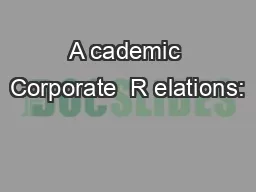

Essential E lements Sacha Patera PhD NACRO Benchmarking Committee CoChair Associate Director of Corporate Relations Northwestern University Emily Abbott NACRO Benchmarking Committee CoChair ID: 635982
Download Presentation The PPT/PDF document "A cademic Corporate R elations:" is the property of its rightful owner. Permission is granted to download and print the materials on this web site for personal, non-commercial use only, and to display it on your personal computer provided you do not modify the materials and that you retain all copyright notices contained in the materials. By downloading content from our website, you accept the terms of this agreement.
Slide1
Academic Corporate Relations: Essential Elements
Sacha Patera, PhDNACRO Benchmarking Committee Co-ChairAssociate Director of Corporate RelationsNorthwestern UniversityEmily AbbottNACRO Benchmarking Committee Co-ChairAssociate Director of Corporate RelationsCalifornia Institute of Technology
NACRO Conference 2011
Aug 1-3, 2011
Ann Arbor MISlide2
Tightened governance rules Shareholder expectations Greater accountabilityGlobal competition
DeregulationCompanies seek greater value from academic relationships Which university priorities match corporate objectives?Corporations have transitioned from donors to investorsSlide3
NACRO 2010 surveys 45 CR programs. What kind of interactions with industry are you seeking?University CR programs are in transitionSlide4
Companies seek comprehensive relationships with universities
Recruitment of students Research collaborations Intellectual property and licensing Intellectual capital and expertise Use of specialized facilities Economic development
Procurement and vending
Executive
education
Advisory roles on boards
….Slide5
No two universities will have identical corporate relations programs:public or private
statussize of faculty and student populations specialization: business, engineering, medical schools, etc.importance in the local economy and business sector engagement Essential elements can be adopted by any CR programSlide6
Institutional support
Mutual benefitsOne-stop shoppingIntegrated research developmentCampus coordinationNACRO BC identifies 5 essential elements of successful CR programsSlide7
Maximize the flow of all corporate resources to support the university’s teaching and research missions
Assigned to coordinate the relationship on campus Identify which University units will deliver the value and help them coordinateEncourages internal sharing, coordination and collaborationsAdjustment of metrics and incentives reflecting comprehensive CR#1: Institutional support underlies a successful CR programSlide8
Identify and match the company’s strategic needs and the university's strengthsBridge cultural and linguistic differencesProvide a consistent university interface for industry
Facilitate connections to university contacts#2: Articulate the mutual benefits of the relationshipSlide9
Examples of mutual benefitsUniversity
benefits from…Company benefits from…Jobs & internships for students; fellowshipsFuture employees, recruitingExecutive education participantsExecutive education training for employeesExpanded research capacity; access to real-world problemsCampus research collaborations; “R” of R&D;
Licensing revenue
Patent
license
Equipment &
facility fees
Access
to specialized equipment
Event funding
Event
sponsorship, publicity and association
Essential Elements of a Productive Twenty-First
Century University
Corporate Relations
Program
Network
of Academic Corporate Relations
Officers, Benchmarking Committee,
White
Patper
, Aug 2, 2011Slide10
#3: CR Programs provide one-stop shopping
Essential Elements of a Productive Twenty-First Century University Corporate Relations Program Network of Academic Corporate Relations Officers, Benchmarking Committee, White Patper, Aug 2, 2011Central to all points of entrySimplifies accessAccelerates access
By-passes silos
Expand
single
projects
Build strategic alliances
Facilitate interactions
Executive
Education
Research Collaborations
Joint Federal Proposals
Philanthropy
Colleges
Schools
Research Centers
Corporate
Relations
Student Recruiting &
Engagement
Commercialization
IP
&
L
icensing
Ec
onomic
D
evelopment
Slide11
#4: Integrate the development of research
Research Administration
Office for Development
Faculty
Company X
needs:
Students
Research
Licensing
Technology Transfer
Office
Corporate
Relations
Better, simpler and faster access
By-passes silos
Facilitate interactionsSlide12
Example of a research alliance that leads to philanthropic involvement
Alliance agreement March 2011Data from Northwestern University provided by S. PateraAnticipated total for FY11
Single gift/
yr
Prior ‘07
Multiple gifts/
yr
Post ’07 Slide13
#5: Facilitate campus coordination
Share informationCommunicate RegularlyCoordinate corporate activityPrevent duplication of efforts
Share metrics
Share internal databases
Engage deans faculty
admins
staff
Share top prospect strategy
Corporate
RelationsSlide14
Metrics that reflect the essential elementsInstitutional support –
campus-wide coordination?Mutual benefits – develop strategies?One-stop shopping – increased interactions?Integrated research development – increased research support?
Campus coordination –
information sharing?
Metrics should reflect the comprehensive nature of CR
INADEQUATE MAXIM
Individual-based
performance
metrics
Contact
visits
Visits proposal development
Proposals
$$Slide15
Example of comprehensive assessment
Incentivize cooperationReward collaboration Slide16
Emily Abbott (Caltech) – BC co-ChairAnne Borchert (Case Western Reserve U)Coleen Burrus
(Northwestern U)Ashley Cooper (U Southern California)Michael Dwyer (Rochester Institute of Technology)Catheryn Fuller (Chicago Booth School of Business)Greg Gibbs (UC Davis)Mary Hanifin (Brown U)Richard Jones (U Chicago)Sean Kassen
(U Notre Dame)Dorothy Kittner
(Washington U)
Shelly Maddex
(Penn State U)
Don McGowan
(Tufts)
Lorena McLaren
(U Washington)
Michael Owen
(U Ontario Institute of Technology)
Sacha Patera
(Northwestern U) –
BC co-Chair
Mark Putnam
(U Houston)
Karla Riker
(Emory U)
Pam Ritter
(Purdue U)
Sarah Schram
(Louisiana State U)
Jon See
(Purdue U)
William Swisher
(Carnegie Mellon U)
Olof Westerstahl
(U Illinois)
Kyan Zeller
(Michigan State U)
Thank you NACRO Benchmarking Committee 2011
!